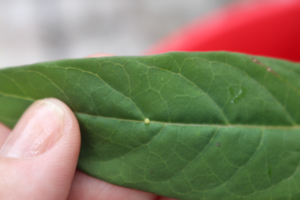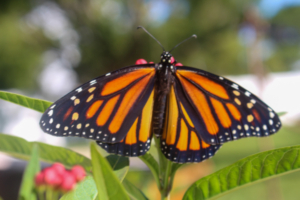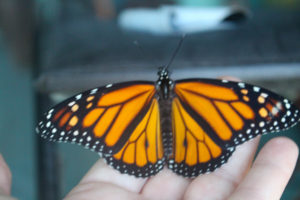Building a Butterfly Habitat
I know it may seem small and insignificant but it’s not about what it is, it’s about what it can become -Dr. Seuss
🦋 Understanding Tropical Milkweed and Monarch Conservation in Florida
At Butterfly Daisy Sanctuary, we support year-round Monarch conservation efforts that are rooted in both experience and education. One ongoing debate in the butterfly gardening world centers around tropical milkweed (Asclepias curassavica)—a widely available and heavily used host plant for Monarch caterpillars in Florida.
While native milkweeds are valuable and ideal in many settings, they often go dormant in the winter months, leaving little to no food for Monarchs—especially Florida’s non-migrating population, which depends on a consistent supply of milkweed to complete their life cycle.
🌿 Our Position on Tropical Milkweed
✔ Tropical milkweed is essential in Florida’s ecosystem, particularly in urban and coastal regions like Tampa Bay, where Monarchs live year-round.
✔ Without tropical milkweed, there would be a sharp decline in Eastern Monarch populations due to a lack of host plants during critical months.
✔ OE is a parasite carried by the Monarchs themselves, not caused by the milkweed. While OE is present on all milkweed types, its spread is influenced by gardening practices, not just the plant species.
✔ We advocate for responsible tropical milkweed care, which includes:
-
Cutting it back in late fall and winter (mimicking native dormancy cycles)
-
Spacing out plantings to reduce contamination
-
Practicing rotational planting and soil management
🌸 Why Both Types of Milkweed Matter
We grow and promote both native and tropical milkweed varieties. Each serves a vital purpose in sustaining Monarch populations:
-
Native milkweeds: Support ecosystem biodiversity and are crucial during active growing seasons.
-
Tropical milkweed: Provides a reliable food source during dormant periods, especially in urban areas and sanctuaries like ours.
🐛 Let’s Educate, Not Eliminate
The key to supporting Monarchs is not to eliminate tropical milkweed—but to educate gardeners, homeowners, and conservationists on responsible care. At Butterfly Daisy, we believe a healthy garden includes:
-
A mix of native nectar and host plants
-
Regular cutbacks of tropical milkweed
-
Ongoing education to monitor for OE and support pollinator health
“It’s not the milkweed—it’s the management.”
Together, we can protect Monarchs by using both heart and science.
🦋 Did You Know? Monarch Survival Rates Are Shockingly Low
Fewer than 10% of Monarch butterfly eggs survive long enough to become butterflies. Once laid on Milkweed leaves, these tiny eggs and caterpillars face threats from ants, spiders, and other predatory insects. But with a little effort, you can help protect them—and even raise your own Monarchs at home!
🌿 Creating a Safe Butterfly Habitat is Easier Than You Think
Building your own butterfly enclosure doesn’t require expensive supplies. In fact, you can start with simple materials you likely already have at home. All you need is:
- Butterfly Enclosure there are many sizes available I suggest start out small.
-
Fresh Milkweed leaves (Monarchs’ only host plant) they can only eat milkweed.
🐛 How to Collect and Protect Monarch Eggs
-
Check your Milkweed plants daily, especially the undersides of the leaves.
-
Look for tiny, white, oval-shaped eggs.
-
Gently cut off the piece of leaf with the egg and place it in your enclosure.
-
Monitor them daily—tiny caterpillars will hatch and start munching soon!
Warning: Raising caterpillars can quickly become addictive and a full-time job! They eat a surprising amount of Milkweed, so be prepared to keep their food source well-stocked.
🌸 How to Attract Monarchs to Your Garden
While Milkweed is essential for Monarch egg-laying and caterpillar feeding, other nectar-rich plants help attract adult butterflies. Consider adding:
-
Daisies
-
Pentas
-
Asters
-
Lavender
-
Butterfly Bush (Buddleia)
These plants will help transform your yard into a thriving butterfly oasis and support the pollinator population all season long.
🧡 At Butterfly Daisy Sanctuary, we believe anyone can make a difference. By creating even a small habitat, you’re helping restore balance to Florida’s delicate ecosystem—one wing at a time.
🌿 Milkweed & Nectar Sources: The Foundation of Monarch Habitat
Whether you’re planting along a roadside, restoring a field, enhancing a wetland, or creating a small urban pollinator garden—milkweed and flowering nectar plants are essential for sustaining Monarch butterflies.
🦋 Why Milkweed Matters
Like many butterflies, Monarchs rely on a single type of plant as a host for their larvae: Milkweed (Asclepias spp.). Monarch butterflies lay their eggs exclusively on milkweed because it is the only plant their caterpillars can eat. Without it, Monarch larvae cannot survive, and the butterfly’s life cycle is disrupted.
By planting milkweed, you’re not just growing a plant—you’re helping raise the next generation of Monarchs.
🌸 Nectar Plants: Fuel for Flight
While Monarchs depend on milkweed to breed, they also require a wide variety of nectar-rich flowers for energy. Adult Monarchs feed on the nectar of many blooming plants throughout the season. Incorporating a diverse mix of native wildflowers ensures your habitat supports butterflies at every stage of their journey.
🌱 Diversity in Milkweed Species
North America is home to over 100 species of milkweed, but only about 25 species are recognized as significant host plants for Monarchs. In Florida and the Southeastern U.S., some of the most beneficial varieties include:
-
Swamp Milkweed (Asclepias incarnata) – prefers moist soil and is ideal for gardens or wetlands
-
Butterfly Milkweed (Asclepias tuberosa) – a drought-tolerant favorite with bright orange blooms
-
Aquatic Milkweed (Asclepias perennis) – a great choice for shady or wet areas
-
Tropical Milkweed (Asclepias curassavica) – suitable for year-round gardens in Florida, when managed responsibly
Each type plays a unique role in building a thriving pollinator habitat.
🧡 At Butterfly Daisy Sanctuary, we’re dedicated to restoring Monarch populations by growing and sharing safe, pesticide-free milkweed and native nectar plants. Your garden can become a vital piece of the puzzle—one that helps Monarchs continue their magical journey.
🌿 Why Milkweed? Nature’s Built-In Defense System
Milkweed isn’t just a food source for Monarchs—it’s a powerful ally in their survival.
🧪 Protective Chemistry: Built to Deter Predators
Milkweed plants produce unique chemical compounds called cardiac glycosides, which are toxic to most vertebrates (animals with backbones). Monarch caterpillars have evolved to consume and store these toxins without being harmed. As a result, both the caterpillars and the adult butterflies become unpalatable and poisonous to many predators.
Some milkweed species contain higher levels of these protective chemicals, and Monarchs have been observed to prefer these varieties when available.
🎨 Bright Colors, Bold Warning: Protective Coloration
Monarchs are not trying to blend in—they’re bold on purpose. Their striking orange-and-black wings and the caterpillars’ vivid yellow, black, and white stripes serve as a clear warning: “I’m poisonous—don’t eat me!”
This natural warning system is incredibly effective. Predators, like birds or lizards, usually only make the mistake once—quickly learning to avoid Monarchs in the future after a single foul-tasting encounter.
🦋 The Viceroy: Nature’s Clever Copycat
The Viceroy butterfly is a master of disguise. With wing patterns and coloration that closely resemble the Monarch’s, the Viceroy takes advantage of the Monarch’s reputation. This form of mimicry offers protection by association—predators often mistake the harmless Viceroy for the toxic Monarch and steer clear.
🌼 At Butterfly Daisy Sanctuary, we educate visitors about the intricate relationships between plants, pollinators, and predators. Milkweed plays a critical role in this ecological balance—not just as a host plant, but as a life-saving line of defense in the wild.





